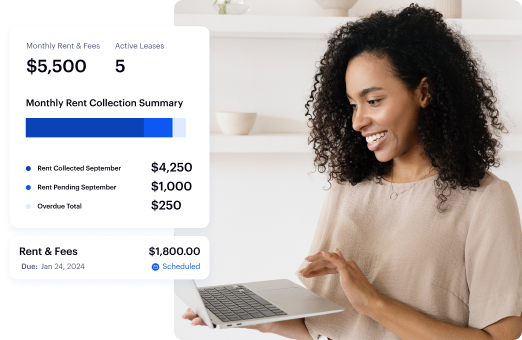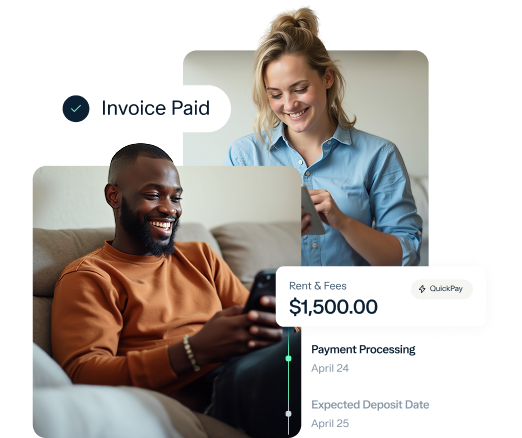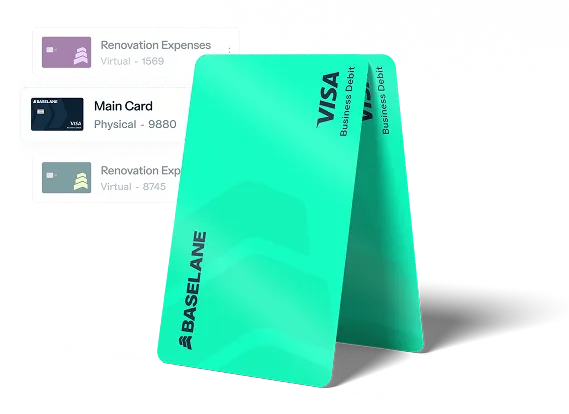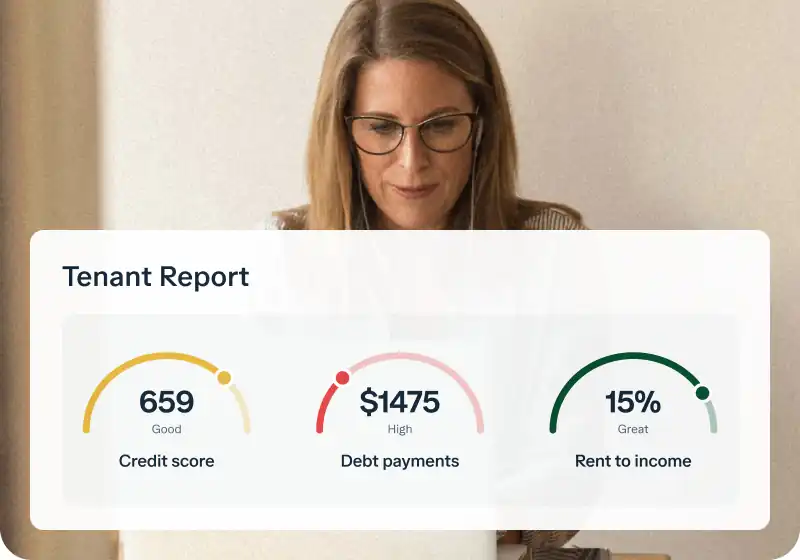Managing rental properties efficiently requires modern solutions, especially when it comes to collecting rent. For landlords and real estate investors, embracing digital payment methods like ACH electronic transfers and eChecks can transform your financial operations. These tools offer a powerful way to simplify rent collection, enhance security, and ensure consistent cash flow.
This guide explores how ACH and eChecks work, their numerous benefits, and how you can seamlessly integrate them into your rental business. You will discover how these technologies not only save time and reduce costs but also provide greater clarity and control over your finances. By leveraging these modern payment methods, you can empower your real estate business to thrive in today's digital landscape.
Key takeaways
- ACH electronic transfers and eChecks are secure, cost-effective digital payment methods for rent collection.
- As of 2025, ACH payments constitute 64.8% of digital rent transactions, making them the leading electronic method for landlords.
- Landlords benefit from lower transaction fees (typically $0.26 to $0.50 per transaction) compared to credit cards.
- Implementing ACH for rent payments streamlines operations, improves cash flow, and offers greater convenience for both parties.
- Modern platforms integrate advanced ACH solutions like "Pay by Bank" and "Guaranteed ACH" for enhanced security and payment assurance.
What are ACH electronic transfers and eChecks?
ACH electronic transfers and eChecks represent key components of the digital payment landscape, offering distinct advantages over traditional methods. These payment methods leverage robust financial infrastructure to move funds securely and efficiently.
Understanding Automated Clearing House (ACH)
The Automated Clearing House, or ACH, is a vast electronic network that facilitates financial transactions across the United States. It handles large volumes of credit and debit transfers between bank accounts. For landlords, an automated clearing house payment allows tenants to send rent directly from their bank account to yours. This system is a reliable backbone for many common digital payments, including direct deposit payroll and bill payments.
ACH transactions are processed in batches, typically three to four times a day, ensuring a steady flow of funds. This batch processing contributes to their cost-effectiveness and security. The network is governed by Nacha rules, which establish clear standards for all participants.
Understanding eChecks
eChecks are essentially digital versions of traditional paper checks, but they operate through the ACH network. Instead of writing out a physical check, tenants provide their bank account and routing numbers electronically. This information is then used to initiate an ACH debit from their account.
The primary appeal of eChecks lies in their ability to eliminate the physical handling and processing of paper checks. They offer the same legal standing as paper checks but with the speed and efficiency of electronic processing. For landlords, eChecks reduce the risk of lost or stolen mail and streamline bookkeeping.
ACH vs. eChecks: Key differences and similarities
While often used interchangeably, there are subtle differences between general ACH transfers and eChecks, though eChecks fundamentally operate as a type of ACH transaction. ACH refers to the overarching network and various types of electronic fund transfers, including direct deposits and direct debits. An eCheck is a specific application within the ACH framework, designed to replicate the function of a paper check digitally. Both methods rely on bank account and routing numbers, bypassing card networks.
The main similarity is that both are bank-to-bank transfers processed through the ACH network, offering lower fees and enhanced security compared to credit cards. The primary distinction often comes down to the initiation process and how they are presented to the user. Many modern platforms simply refer to all direct bank transfers as ACH payments.
ACH vs. eChecks: How do they compare against other electronic payments
When considering various digital payment options, it's helpful to understand where ACH and eChecks stand against alternatives like wire transfers. Unlike wire transfers, which are typically faster and more expensive, ACH payments are designed for recurring and high-volume transactions with lower costs. You can learn more about these distinctions by exploring ACH vs wire transfer. Wire transfers are often reserved for time-sensitive, larger-sum payments.
Credit and debit card payments, while instant for the payer, incur higher processing fees for the recipient, typically 2-4% of the transaction amount. P2P apps like Zelle or Venmo are convenient for smaller, informal payments but often lack the robust tracking, reporting, and legal protections needed for rent collection. ACH and eChecks strike a balance, offering cost-effectiveness, security, and the necessary infrastructure for formal, recurring payments.
The rise of digital rent payments trends & statistics
The landscape of rent collection is rapidly evolving, with digital methods gaining significant traction among landlords and tenants alike. This shift is driven by a desire for greater efficiency, security, and convenience. As technology advances, traditional payment methods are becoming less prevalent.
Current adoption rates for ACH in the rental market
ACH payments, including eChecks, have firmly established themselves as the preferred method for digital rent transactions. As of 2025, ACH payments account for 64.8% of digital rent transactions. This figure solidifies ACH as the leading electronic rent payment method among U.S. landlords and property managers, according to Baselane (2025) and Multifamily Dive (2024–2025). This high adoption rate underscores the reliability and effectiveness of the ACH network for recurring rent payments. Many landlords find that offering free ACH transfers significantly boosts digital payment utilization, reaching 84.7% when fees are absorbed. However, this rate drops to 47% when fees are passed to renters, according to Multifamily Dive.
Overall growth of the ACH Network
The broader ACH network continues to expand its role across the U.S. economy, reflecting a nationwide preference for electronic transactions. In Q1 2025, overall ACH payment volume rose by 4.2% year-over-year in the U.S. This growth involved 8.5 billion payments processed, highlighting the network’s expanding role, according to Baselane (2025). In Q2 2024, the ACH network processed 8.3 billion payments, marking a 6.3% increase over the same period in 2023, as reported by Aeropay (2024). These statistics demonstrate the increasing trust and reliance on ACH for diverse financial needs.
The ongoing shift away from traditional payment methods
Despite the surge in digital payments, a significant portion of renters still relies on traditional methods. Nearly half of renters still pay by traditional paper checks, indicating an ongoing opportunity for digital conversion and further adoption of ACH/eChecks, according to Multifamily Dive (2024–2025). This statistic highlights the transition phase the rental market is currently in. Landlords who offer easy-to-use digital options can help accelerate this shift, reducing the administrative burden associated with physical payments. The convenience of digital methods is slowly but surely winning over both landlords and tenants.
How ACH rent payments work a step-by-step process for landlords
Understanding the mechanics of ACH rent payments demystifies the process and helps landlords implement it confidently. While the underlying technology is complex, the user experience is designed to be straightforward. Following a clear protocol ensures smooth and secure transactions.
Tenant authorization for receiving ACH payments
The first critical step in initiating an ACH rent payment is obtaining explicit authorization from your tenant. This typically involves them providing their bank account number and routing number. They will also grant permission for you or your payment processor to debit their account for rent. Landlords can refer to detailed guides on how to receive ACH payments into their bank account.
This authorization can be a one-time setup for recurring payments, saving both parties time each month. Digital platforms often handle this securely through an online portal. A clear authorization process helps prevent disputes and ensures compliance.
Landlord initiates ACH billing
Once authorization is secured, the landlord or their chosen payment platform initiates the rent payment. This process involves submitting a request to debit the tenant's account for the agreed-upon rent amount. For efficient management, landlords can utilize systems that support ACH billing. This allows for timely and accurate payment requests.
Many platforms allow landlords to schedule these payments in advance, aligning with monthly rent due dates. This automation reduces manual effort and the risk of human error. It also ensures consistent payment processing.
Transmission to the ACH Network
The initiated payment request is then transmitted to the ACH network through the landlord’s bank or payment processor. These requests are batched together with other transactions for efficient processing. The ACH network acts as a central clearing facility for these electronic transfers.
This network ensures that transactions are routed correctly between financial institutions. It processes billions of payments annually, demonstrating its reliability. Your payment processor handles the technical details of this transmission.
Validation, routing, and settlement
Upon receiving the batch of transactions, the ACH network validates the payment information. It then routes the debit request to the tenant’s bank and the credit request to the landlord’s bank. This process involves verifying account numbers and ensuring funds are available.
If sufficient funds are present, the tenant’s bank releases the funds. These funds are then settled into the landlord’s bank account. This settlement typically occurs within 1-3 business days, providing quick and reliable cash flow management for landlords, according to Aeropay (2024).
Confirmation and posting to accounts
After successful settlement, both the tenant’s and landlord’s bank accounts are updated. The payment is reflected in their respective account statements. Many digital payment platforms provide real-time status updates and confirmations.
These confirmations give both parties peace of mind that the transaction was successful. They also provide a clear digital record for bookkeeping purposes. This transparency is a significant advantage over paper checks.
Setting up auto ACH payment for recurring rent
For recurring rent payments, landlords can easily set up an auto ACH payment system. This allows tenants to authorize automatic debits from their bank account on a specific date each month. This automation significantly reduces the administrative burden on landlords. It also helps tenants avoid late fees by ensuring consistent, on-time payments.
This feature is a cornerstone of modern rent collection. It benefits both landlords and tenants by increasing predictability and reducing manual effort. Many payment platforms offer tools to manage and track these recurring payments.
Why landlords choose ACH & eChecks
Modern landlords are increasingly turning to ACH and eChecks for their rent collection needs, driven by a range of compelling benefits. These electronic payment methods offer significant improvements over traditional approaches, positively impacting both financial efficiency and operational ease. Embracing digital payments helps landlords gain clarity and control over their rental business.
Cost efficiency significant savings on transaction fees
One of the most attractive benefits of ACH payments for landlords is their low transaction cost. Landlords benefit from significantly lower transaction fees, typically $0.26 to $0.50 per transaction, for ACH payments. This is a stark contrast to credit card payments, which typically incur fees of 3-5%, according to Aeropay (2024) and Multifamily Dive (2024–2025). These savings can accumulate quickly, especially for landlords managing multiple properties. Reduced fees directly contribute to higher net operating income.
Enhanced security & fraud reduction
ACH transactions are processed through a highly secure banking network, offering robust protection against fraud. Unlike paper checks, which can be lost or stolen and easily manipulated, ACH payments move funds electronically with encryption. This reduces the risk of check fraud, a common concern for landlords. Furthermore, modern fintech solutions often include advanced tenant verification processes.
U.S. adults use the same primary checking account for more than 17 years on average, making linked bank accounts a more durable payment information source than credit cards, which expire every three years, according to Aeropay (2024). This longevity of bank account information further enhances security. Landlords can have greater confidence in the integrity of their rent collection.
Streamlined operations & automated rent collection
Implementing ACH payments dramatically streamlines rent collection and related administrative tasks. Automated systems handle invoicing, payment reminders, and late fees, freeing up valuable time for landlords. Platforms offering automated rent collection reduce the need for manual intervention. This automation helps landlords take back time to focus on growing their portfolio.
The reduction in manual busywork allows landlords to dedicate more energy to strategic decisions. Automated reconciliation and reporting also simplify bookkeeping. This efficiency directly impacts overall business productivity.
Improved cash flow & financial predictability
With ACH, rent payments typically settle within 1-3 business days, providing landlords with a more predictable and faster cash flow. This speed contrasts sharply with paper checks, which can take 5-10 business days to clear. Consistent cash flow is vital for managing property expenses, mortgage payments, and other financial obligations. Improved financial predictability allows for better budgeting and investment planning.
Convenience and flexibility for both landlords and tenants
ACH and eChecks offer unparalleled convenience for both parties involved in a rental agreement. Tenants can set up auto-payments, ensuring rent is never late and eliminating the need to remember due dates or mail checks. This flexibility also extends to innovative solutions like Flexible Rent Collection and specialized split rent payments app. These options cater to diverse tenant needs.
For landlords, the ability to collect rent electronically from anywhere at any time simplifies management. This convenience enhances the landlord-tenant relationship by providing a modern, hassle-free payment experience. Both parties benefit from a system that integrates seamlessly into their daily lives.
Understanding ACH payment types & advanced solutions
The ACH network is continuously evolving, introducing more sophisticated solutions to meet the demands of modern financial transactions. For landlords, understanding these advanced payment types can offer even greater security, speed, and reliability in rent collection. These innovations go beyond traditional ACH processes.
Traditional ACH vs. “pay by bank” API-based bank linking
Traditional ACH setup often involves manually entering a bank account and routing numbers, which can be prone to errors. "Pay by Bank" technology, by contrast, uses API-based bank linking to create a more secure and seamless experience. Tenants directly connect their bank account through their bank’s online portal or app, without needing to share sensitive information directly with the landlord or payment platform. This method enhances security by leveraging bank-level authentication.
"Pay by Bank" offers immediate verification of funds, which can significantly reduce the risk of failed payments. This modern approach is gaining traction for its enhanced user experience and reduced fraud potential. It creates a more direct and reliable link between the tenant's bank and the payment system.
The advantage of guaranteed ACH payments
Guaranteed ACH payments represent a significant advancement for landlords, addressing a common concern: insufficient funds (NSF). Traditional ACH payments can sometimes fail if the tenant's account lacks sufficient funds, leading to delays and potential fees. Guaranteed ACH solutions mitigate this risk by providing payment assurance to the landlord. These advanced services often use real-time bank data to verify funds before the transaction is initiated, or they offer a guarantee that the funds will be paid even if the tenant's account balance is low.
This assurance means landlords receive their rent on time, even if there's a temporary issue with the tenant's account. Such solutions are often offered by specialized fintech companies. The elimination of NSF risk provides invaluable peace of mind and financial predictability for landlords, according to Aeropay.
Potential drawbacks and how to mitigate them
While ACH and eChecks offer many advantages, landlords should be aware of potential drawbacks to ensure a smooth rent collection process. Understanding these challenges and implementing mitigation strategies is key to maximizing the benefits of electronic payments. Proactive measures can prevent common issues.
ACH processing times and settlement delays
One common concern for landlords is the processing time associated with ACH payments. While generally faster than paper checks, ACH transfers typically settle in 1–3 business days, according to Aeropay (2024). This is not instantaneous like a credit card transaction. Landlords need to factor in this delay when setting rent due dates and managing cash flow. It is important to communicate clear payment deadlines to tenants, encouraging them to initiate payments a few days before the due date.
Handling failed payments & insufficient funds
Payments can fail due to insufficient funds (NSF), incorrect account information, or account closures. When an ACH payment fails, landlords may incur a return fee from their bank. To mitigate this, consider implementing automated notifications for failed payments and a clear policy for handling late payments and associated fees. Modern platforms can alert you to potential NSF issues proactively. Utilizing "Guaranteed ACH" solutions can also significantly reduce this risk, as they offer payment assurance, according to Aeropay (2024).
Addressing privacy concerns & ensuring data security
Collecting tenants' bank accounts and routing numbers raises privacy and data security concerns. Landlords must ensure they use secure platforms that comply with data protection regulations. Avoid storing sensitive banking information in insecure locations. Opt for payment systems that utilize encryption and robust security protocols to protect tenant data. Educate tenants on the security measures in place to build trust.
Navigating technical issues & payment disputes
Technical glitches or payment disputes, though rare, can occur. Tenants might claim a payment was initiated but not received, or dispute a charge. Choose a payment platform with reliable customer support for both landlords and tenants. Maintain clear records of all payment communications and transactions. This documentation is crucial for resolving any issues swiftly and effectively. Having a clear dispute resolution process outlined in the lease agreement can also be helpful.
Setting up ACH & eCheck payments for your rental property
Implementing ACH and eCheck payments for your rental property can significantly streamline your financial operations. The setup process can vary depending on whether you opt for direct bank integration or utilize specialized property management software. Careful consideration of these options will ensure a secure and efficient system.
Direct bank account ACH setup
Some landlords may choose to set up ACH payments directly through their bank. This often involves working with your bank to establish a system for initiating debits from tenant accounts. You may need to provide specific forms and authorization agreements to your bank. Understanding the basics of a bank account ACH is beneficial for this approach.
While direct bank setup can offer control, it often involves more manual processing and administrative work on your part. You might be responsible for tracking authorizations, managing payment schedules, and handling exceptions. This method is generally suitable for landlords with a smaller number of properties.
Utilizing property management rent collection software
Many landlords find that using dedicated property management rent collection software simplifies the entire ACH setup and management process. These platforms are designed with landlords in mind, offering automated workflows and integrated features. They handle tenant authorization, payment initiation, and tracking within a user-friendly interface. Baselane, for example, integrates banking, rent collection, and bookkeeping. This creates a seamless financial management experience.
These software solutions often provide tenant portals, automated reminders, and detailed financial reporting. They reduce the administrative burden significantly compared to manual bank-level setup. Moreover, many platforms offer free ACH options for landlords.
Key information needed for ACH payment setup
Regardless of the method chosen, certain key pieces of information are essential for successful ACH payment setup. You will need your tenant’s bank account number and routing number. You also need their explicit authorization to debit their account. A detailed guide on ACH payment setup provides all the necessary information.
For your landlord account, you will need your own bank account and routing number. Ensure all information is entered accurately to avoid payment delays or failures. Double-checking these details is a crucial step.
Considerations for ACH for accounts payable
Beyond rent collection, landlords can also leverage ACH for their accounts payable, such as paying property taxes, utility bills, or vendor invoices. Implementing ACH for accounts payable streamlines outgoing payments. This further enhances financial efficiency and control. Automated payment systems can handle recurring expenses.
Using ACH for both incoming and outgoing funds provides a comprehensive digital financial management system. This reduces reliance on checks for payments to contractors or service providers. Integrated platforms can manage both sides of your rental property finances.
How do ACH and eChecks compare to other rent collection methods?
Choosing the right rent collection method is a critical decision for landlords, impacting efficiency, cost, and tenant satisfaction. A comprehensive comparison reveals the distinct advantages of ACH and eChecks over alternatives. This table provides a clear overview of various payment options.
This comparison highlights that integrated platforms like Baselane offer superior automation, record-keeping, and convenience. They combine the low fees and security of ACH with the advanced features of dedicated software. Landlords should weigh these factors carefully when making their choice.
Legal considerations for requiring electronic payments
While the benefits of ACH and eChecks are clear, landlords must navigate legal considerations when requiring electronic payments. Tenant protection laws vary significantly, and understanding these regulations is crucial for compliance. Failing to adhere to local and state laws can result in legal issues.
State and local regulations on rent payment methods
The legality of requiring tenants to pay rent exclusively through electronic means, such as ACH, depends on state and local laws. Some jurisdictions have explicit rules that prevent landlords from mandating electronic payments. These laws often aim to protect tenants who may not have bank accounts or access to digital payment methods. Landlords should consult with legal counsel or local housing authorities to understand specific requirements in their operating areas. A general rule of thumb is that if you operate in multiple states, you'll need to check the laws in every state, for example, using New York as an example [Verification/Source Required].
The importance of offering alternative options
Even in areas where electronic payments can be required, many jurisdictions strongly encourage or mandate offering alternative payment methods. This ensures accessibility for all tenants, regardless of their financial or technological capabilities. While landlords can generally specify acceptable payment methods, some jurisdictions require offering multiple options, making it crucial for landlords to check local tenant rights and regulations, according to Azibo (2024). Providing options like paper checks or money orders, even if less preferred, can prevent legal challenges and promote positive tenant relations. It is always wise to be flexible and accommodating to a diverse tenant base.
Choosing the right rent payment system for ACH rent collection
Selecting the ideal rent payment system is a pivotal decision for landlords embracing digital collection. The right platform not only facilitates ACH payments but also integrates seamlessly with other aspects of property management. It should simplify your financial life, allowing you to focus on growth.
Essential features to look for in a platform
When evaluating rent payment systems, landlords should prioritize several key features. Look for platforms that offer automated rent collection, including reminders and late fee application. Robust security measures, such as bank-level encryption and tenant verification, are paramount. Integrated bookkeeping and reporting tools will save significant time during tax season. Consider platforms that provide a dedicated tenant portal for ease of payment and communication.
Customer support and ease of use are also vital. A good platform should be intuitive for both landlords and tenants, with responsive support available if issues arise. Ensure the platform supports various payment methods, including ACH, to cater to all tenants. Transparency in fee structures is also important.
How Baselane simplifies ACH rent payments for landlords
Baselane is designed specifically for real estate investors and landlords, offering a comprehensive suite of financial tools integrated under one roof. We streamline ACH rent collection with automated invoicing, reminders, and direct deposits into your Baselane Banking account. Our platform provides real-time payment notifications and tracking, giving you a clear view of your cash flow. This means no more chasing tenants or late-night stressing about rent.
Beyond rent collection, Baselane helps you organize your finances with unlimited banking accounts for each property, security deposits, and rehab savings. These accounts offer an Annual Percentage Yield (APY) on deposits, FDIC insurance available for funds on deposit through Thread Bank, Member FDIC. Pass-through insurance coverage is subject to conditions. Our integrated bookkeeping automatically tags transactions by property and Schedule E category, making tax time effortless. With Baselane, you can easily manage your rent collection and banking on one platform.
Managing finances with multiple bank accounts
For real estate investors, managing finances effectively often involves segmenting funds for different properties or purposes. This is why setting up multiple bank accounts for real estate is a common and recommended strategy. It helps maintain clear financial boundaries, simplify bookkeeping, and prepare for tax season. You might wonder, is it good to have multiple bank accounts for your rental business? The answer is often yes, as it provides a clear view of each property's performance.
Baselane supports this best practice by allowing you to create unlimited banking accounts, each with its own virtual and physical debit cards. This enables automated property tagging for expenses. When choosing the best bank for multiple accounts, look for platforms that offer this flexibility and integration. Baselane provides a robust business bank account with sub accounts specifically designed for real estate investors.
What about EFT for rent?
Electronic Funds Transfer (EFT) is an umbrella term that includes various forms of electronic money movement, with ACH being a prominent type of EFT. Therefore, when discussing EFT for rent, you are largely referring to ACH payments. While other EFT methods exist, ACH is the most common and suitable for recurring rent collection due to its cost-effectiveness and batch processing capabilities. Understanding that ACH is a form of EFT clarifies the terminology. For landlords, focusing on ACH-enabled platforms covers the essential electronic transfer needs for rent.
Embrace the future of rent collection with confidence
The adoption of ACH electronic transfers and eChecks is no longer a luxury but a necessity for modern landlords and real estate investors. These payment methods offer unparalleled efficiency, security, and cost savings, transforming the way you manage your rental properties. By moving away from outdated paper processes, you can take back valuable time and gain greater clarity over your finances. This strategic shift empowers you to focus on growing your passive income and expanding your real estate portfolio.
Embrace the future of rent collection with confidence by integrating reliable ACH and eCheck solutions into your operations. Baselane is committed to providing landlords with the tools needed to thrive in this evolving landscape. Our integrated banking, rent collection, and bookkeeping platform is designed to make property management simpler and more profitable.
FAQs
What is an ACH electronic transfer for rent payment?
An ACH electronic transfer for rent payment is a digital transaction that moves funds directly from a tenant's bank account to a landlord's bank account through the Automated Clearing House network. It's a secure and cost-effective method for recurring rent collection.
How does an ACH electronic check work?
An ACH electronic check (eCheck) functions like a digital version of a paper check. A tenant provides their bank account and routing number electronically, authorizing a one-time or recurring debit from their account via the ACH network.
What are the benefits of using ACH for rent collection?
Landlords benefit from significantly lower transaction fees, enhanced security, automated record-keeping, and improved cash flow predictability. Tenants enjoy the convenience of auto-pay and reduced risk of late payments.
Can a landlord require ACH for rent payments?
The ability to require ACH for rent payments depends on state and local tenant laws. Many jurisdictions require landlords to offer alternative payment methods to accommodate all tenants. Always check local regulations.
What happens if an ACH rent payment fails?
If an ACH rent payment fails, typically due to insufficient funds or incorrect account information, the landlord may incur a return fee. Modern payment platforms often provide notifications for failed payments and tools to manage such situations.

















.jpg)